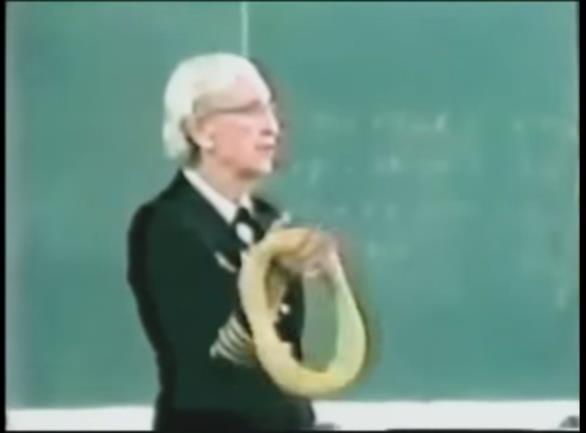
NavList:
A Community Devoted to the Preservation and Practice of Celestial Navigation and Other Methods of Traditional Wayfinding
From: Frank Reed
Date: 2017 Jan 3, 11:16 -0800
Lu Abel, you wrote:
"very famous early computer pioneer Grace Murray Hopper. She handed out foot-long chunks of coaxial cable, pointing out that electromagnetic waves would traverse the cable in one nanosecond. Ever since I've remembered 'one foot equals one nanosecond' "
Yes, this visual tool is most certainly due to Grace Hopper. For those who don't know her, she had quite a career in early computing and in the USN (see Wikipedia: https://en.wikipedia.org/wiki/Grace_Hopper). There is a USN guided-missile destroyer, USS Hopper, named after her. She was a skilled communicator as well as a computer pioneer, and those portable nanoseconds were her trademark. She deserves continuing credit for that visualization of the speed of light in electronic systems. I vividly remember when she was interviewed in 1983 on "60 Minutes" (for those who aren't familiar, that's a prominent tv news magazine here in the USA) and showed off one of her nanosecond cables. It's mentioned in the Wikipedia article:
She often recounted that during her service she was frequently asked by Admirals and Generals why satellite communication would take so long. So during many of her lectures, she illustrated a nanosecond using salvaged obsolete Bell System 25 pair telephone cable, cut it to 11.8 inch (30 cm) lengths, the distance that light travels in one nanosecond, and handed out the individual wires to her listeners.
And in another Wikipedia article:
The light-nanosecond was popularized as a unit of distance by Grace Hopper as the distance which a photon could travel in one thousand-millionth of a second (roughly 30 cm or one foot): "The speed of light is one foot per nanosecond." In her speaking engagements, she was well known for passing out light-nanoseconds of wire to the audience, and contrasting it with light-microseconds (a coil of wire 1,000 times as long) and light-picoseconds (the size of ground black pepper). Over the course of her life, she found many uses for this visual aid, including demonstrating the waste of sub-optimal programming, illustrating advances in computer speed, and simply giving young scientists and policy makers the ability to conceptualize the magnitude of very large and small numbers.
There's a video available (here on youtube) from one of her many public lectures where she describes the meaning of these "nanoseconds". She also holds up a "microsecond", which you can see in the attached photo below.
Frank Reed







